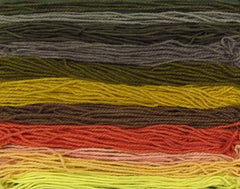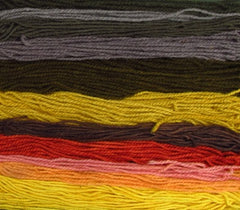Ratio Rainbow
 There are three mushroom dye reference books that I use on a regular basis. Mushrooms for Color, by Miriam C. Rice; Rainbow Beneath My Feet, by Arleen and Alan Bessette; and Mushrooms for Dyes, Paper, Pigments and Myco-Stix, also by Miriam C. Rice. I often check all three when looking into the dye potential of unfamiliar mushrooms, or to see how mordants generally affect the color of a specific mushroom dye. I usually refer to Miriam C. Rice’s books for a pre-mordant recipe.
There are three mushroom dye reference books that I use on a regular basis. Mushrooms for Color, by Miriam C. Rice; Rainbow Beneath My Feet, by Arleen and Alan Bessette; and Mushrooms for Dyes, Paper, Pigments and Myco-Stix, also by Miriam C. Rice. I often check all three when looking into the dye potential of unfamiliar mushrooms, or to see how mordants generally affect the color of a specific mushroom dye. I usually refer to Miriam C. Rice’s books for a pre-mordant recipe.
These are all great books that cover a lot of topics while focusing on the color range possibilities of mushrooms; however, they do not contain recipes for ratios. This is understandable considering the scope of the books and the fact that amount of mushroom needed to make a good dye varies from species to species, and depends on the condition of the fungus; including its maturity, exposure to weather as well as region it which it was collected.
It would take multiple experiments to come up with a ball park range for each species. Collectively, I am sure plenty of research has been done, but it is extremely tedious to attempt to tease this kind of information out of the vaults of blogs and comment threads where I am sure it must be discussed. To save time and keep my sanity, I have resorted to first hand experimentation.
In the old days, I just dumped roughly the same volume of dried mushroom as wool – not paying attention to weights. I used fresh mushrooms or dry mushrooms indiscriminately, and gauged the dye just by eyeballing the mass and intuitively saying when it looked like enough. That method made for some beautiful but overly strong dyes, and if space or time to deal with the left-over dye-baths is a concern, that can mean a lot of waste.
 Today I decided to see how far these dye fungi could go. I tried a series of equal weights of dried mushroom to dry wool and was surprised by the intensity of the dyes with such small amounts of fungi. For the known strong dyers, Phaeolus schweinitzii and Cortinarius semisanguineus, I pushed the limits to 1 part mushroom to five parts wool, just to see the reaches of their dye potential. Both produced great colors; the Cortinarius semisanguineus a cherry-red with alum and grapey-gray with iron, and the Phaeolus a golden-yellow with alum and rich golden-green with iron. Omphalotus olivascens at 1:1 gave a lovely blue-gray-violet with alum and dark forest green with iron with subsequent dye-baths yielding equally strong dye; indicating in this case 1:1 was perhaps more than enough.
Today I decided to see how far these dye fungi could go. I tried a series of equal weights of dried mushroom to dry wool and was surprised by the intensity of the dyes with such small amounts of fungi. For the known strong dyers, Phaeolus schweinitzii and Cortinarius semisanguineus, I pushed the limits to 1 part mushroom to five parts wool, just to see the reaches of their dye potential. Both produced great colors; the Cortinarius semisanguineus a cherry-red with alum and grapey-gray with iron, and the Phaeolus a golden-yellow with alum and rich golden-green with iron. Omphalotus olivascens at 1:1 gave a lovely blue-gray-violet with alum and dark forest green with iron with subsequent dye-baths yielding equally strong dye; indicating in this case 1:1 was perhaps more than enough.
 Though not quite satisfied with the depth of a 1:1 dye, I increased the ratios, this time using two parts fungi per weight to one part wool. Not wanting to double all of the dyes I increased to 2:3 for Cortinarius semisanguineus, Letharia vulpina. The results were noticeable and definitely more impressive. However, there was a lot of dye left in the jars.
Though not quite satisfied with the depth of a 1:1 dye, I increased the ratios, this time using two parts fungi per weight to one part wool. Not wanting to double all of the dyes I increased to 2:3 for Cortinarius semisanguineus, Letharia vulpina. The results were noticeable and definitely more impressive. However, there was a lot of dye left in the jars.
 To maximize mushroom dyes it is best to make time for subsequent dye-baths. Often, the exhaustive dye-bath reveals the excess pigments that the first dye-bath failed to capture. These might be colors that you didn’t realize were there. In the case of Cortinarius semisanguineus, the reds binds to the alum mordanted wool first and second dye-baths do not give a paler version of the cherry-red, but instead give a peachy-orange. Phaeolus schweinitzii gives a bright yellow with alum mordant that just dulls to straw-beige in a second bath, but the iron mordanted greens seem to go on forever.
To maximize mushroom dyes it is best to make time for subsequent dye-baths. Often, the exhaustive dye-bath reveals the excess pigments that the first dye-bath failed to capture. These might be colors that you didn’t realize were there. In the case of Cortinarius semisanguineus, the reds binds to the alum mordanted wool first and second dye-baths do not give a paler version of the cherry-red, but instead give a peachy-orange. Phaeolus schweinitzii gives a bright yellow with alum mordant that just dulls to straw-beige in a second bath, but the iron mordanted greens seem to go on forever.
Ratios for dye species vary; however, there are a limited number of North American mushroom dyes that are tried, true and solid. I am working out ratio ranges for as many of these that I can access. Please let me know about your ratio experiments and if you have any rules of thumb. So far, I have not figured out a way to measure fresh mushrooms with any consistency and still rely on that intuitive voice that tells me when enough is enough. How do you work with fresh mushrooms?

